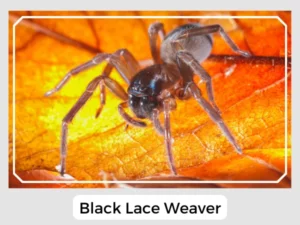The spider realm is diverse and filled with intriguing species. The Amaurobius ferox is one such captivating specimen. In this article, we’ll delve deeper into its unique characteristics and behaviors.

Amaurobius ferox females are known to produce a silky egg sac within their retreats, usually attached to the ceiling or walls of the retreat.
Unlike typical orb-weaver spiders, Amaurobius ferox creates a tangle web, often with a tubular retreat where the spider resides during the day.
While they do have venom to subdue their prey, they aren’t considered dangerous to humans. A bite might cause mild discomfort, but severe reactions are extremely rare.
Yes, like most spiders, the Black Lace Weaver can bite if threatened or provoked. However, it’s typically reluctant to bite and will more often flee from perceived threats.
The Amaurobius ferox, also known as the Black Lace Weaver spider, holds a significant role in maintaining the balance of its ecosystem. By feeding on small insects and other spiders, this species helps to control the population of these organisms, preventing them from becoming pests. This spider’s intricate webbing also provides shelter and a hunting ground, contributing to its local habitat.
Natural Predators: The Amaurobius ferox, despite being a predator itself, is not exempt from the circle of life. Birds, larger spiders, and some species of wasps are known to prey on this spider. These natural predator relationships help to keep the population of Amaurobius ferox in check, contributing to the ecological balance within their habitats.
Prey-Predator Dynamics: The dynamics between the Amaurobius ferox and its prey are intriguing. This spider utilizes its venom to subdue its prey, primarily small insects and other spiders, which it captures in its tangle web. The venom, while potent for its prey, is not considered dangerous to humans.
Relationship with Humans: While the black lace weaver spider does have the ability to bite, it typically avoids human interaction and will more likely flee than attack. Bites are extremely rare and, when they do occur, typically result in mild discomfort rather than severe reactions. This spider prefers to reside in natural settings like walls, fences, and tree barks, though it can sometimes be found in human dwellings.
| Feature | Detail |
|---|---|
| Distribution | Found mainly in Europe, but can be located in other parts of the world. |
| Habitat | Prefers walls, fences, and tree barks. |
| Diet | Feeds on small insects and other spiders. |
| Lifespan | Up to 2 years. |
In conclusion, the black lace weaver is a fascinating member of the spider kingdom, playing a vital role in controlling insect populations and showcasing unique maternal behaviors.
The spider realm is diverse and filled with intriguing species. The Amaurobius ferox is one such captivating specimen. In this article, we’ll delve deeper into its unique characteristics and behaviors.

Amaurobius ferox females are known to produce a silky egg sac within their retreats, usually attached to the ceiling or walls of the retreat.
Unlike typical orb-weaver spiders, Amaurobius ferox creates a tangle web, often with a tubular retreat where the spider resides during the day.
While they do have venom to subdue their prey, they aren’t considered dangerous to humans. A bite might cause mild discomfort, but severe reactions are extremely rare.
Yes, like most spiders, the Black Lace Weaver can bite if threatened or provoked. However, it’s typically reluctant to bite and will more often flee from perceived threats.
The Amaurobius ferox, also known as the Black Lace Weaver spider, holds a significant role in maintaining the balance of its ecosystem. By feeding on small insects and other spiders, this species helps to control the population of these organisms, preventing them from becoming pests. This spider’s intricate webbing also provides shelter and a hunting ground, contributing to its local habitat.
Natural Predators: The Amaurobius ferox, despite being a predator itself, is not exempt from the circle of life. Birds, larger spiders, and some species of wasps are known to prey on this spider. These natural predator relationships help to keep the population of Amaurobius ferox in check, contributing to the ecological balance within their habitats.
Prey-Predator Dynamics: The dynamics between the Amaurobius ferox and its prey are intriguing. This spider utilizes its venom to subdue its prey, primarily small insects and other spiders, which it captures in its tangle web. The venom, while potent for its prey, is not considered dangerous to humans.
Relationship with Humans: While the black lace weaver spider does have the ability to bite, it typically avoids human interaction and will more likely flee than attack. Bites are extremely rare and, when they do occur, typically result in mild discomfort rather than severe reactions. This spider prefers to reside in natural settings like walls, fences, and tree barks, though it can sometimes be found in human dwellings.
| Feature | Detail |
|---|---|
| Distribution | Found mainly in Europe, but can be located in other parts of the world. |
| Habitat | Prefers walls, fences, and tree barks. |
| Diet | Feeds on small insects and other spiders. |
| Lifespan | Up to 2 years. |
In conclusion, the black lace weaver is a fascinating member of the spider kingdom, playing a vital role in controlling insect populations and showcasing unique maternal behaviors.